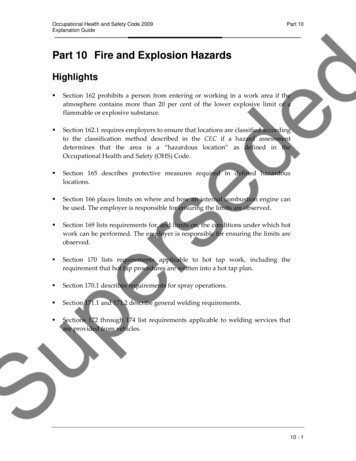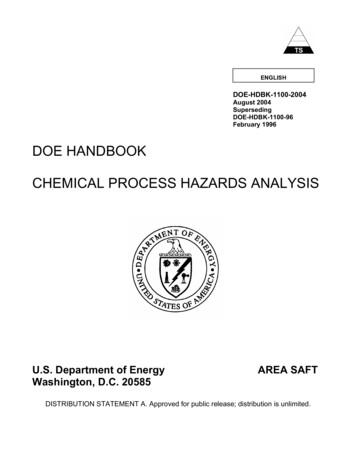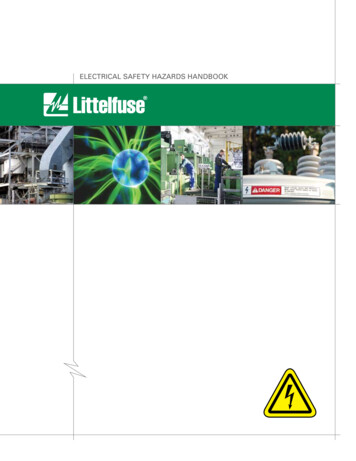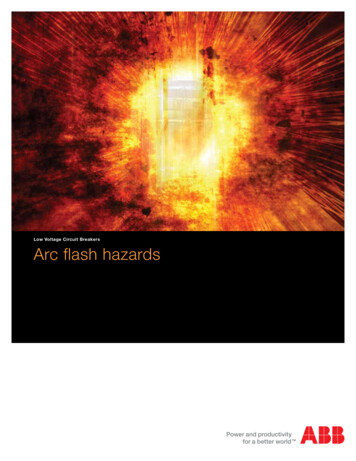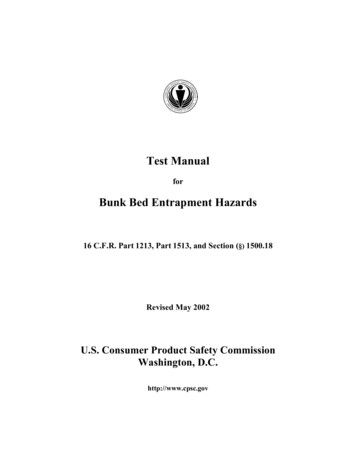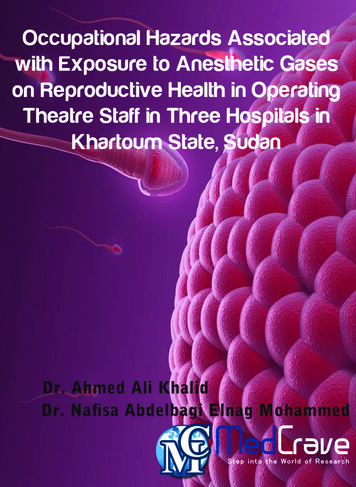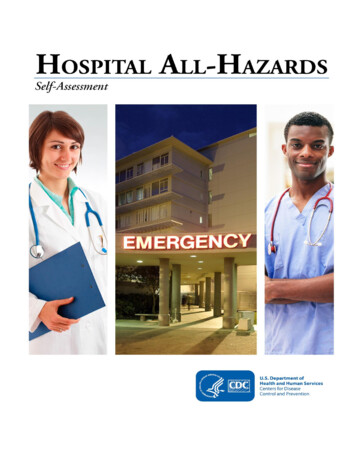
Transcription
Hospital All-Hazards Self-Assessment (HAH)ContentsWelcome Message . 3How To Use This Tool . 3Purpose. 5Goals . 5Objectives . 5Target Audience . 6Format . 6Expected Outcome . 71. PLANNING FRAMEWORK . 82. COMMAND AND CONTROL. 153. AUTHORIZED PERSONNEL. 194. NOTIFICATION SYSTEMS . 215. ACTIVATING THE PLAN. 226. RESPONSE PROTOCOLS . 237. COMMUNICATION SYSTEMS. 268. STAFFING CONSIDERATIONS . 279. SECURITY AND ACCESS . 3010. INTERNAL TRAFFIC . 3211. EXTERNAL TRAFFIC . 3312. PATIENT RECEPTION . 3513. EVACUATING HORIZONTALLY AND VERTICALLY . 3814. SHELTERING-IN-PLACE. 4215. ISOLATED OR OUT OF COMMUNICATION . 4316. VISITORS . 4517. COMMUNICATION AND MEDIA . 4618. RESOURCES . 5019. PHARMACEUTICALS . 5320. SURVEILLANCE. 5521. INFECTION CONTROL . 5722. STAFF EDUCATION AND TRAINING . 6023. POST-MORTEM CARE . 6224. RECOVERY PROTOCOLS . 6425. EXERCISING THE PLAN . 6726. INFRASTRUCTURE . 68Resource List . 69Hospital All-Hazards Self-Assessment2
Welcome MessageWelcome to the Centers for Disease Control and Prevention Healthcare Preparedness Activity's(CDC–HPA's) Hospital All-Hazards Self-Assessment, or HAH. This tool is designed to help youassess and identify potential gaps in your facility's all-hazards emergency plan(s). Upon completingthe HAH, you can use it to modify aspects of these plan(s). You are encouraged to update the HAHas changes to your plan(s) are made, and to include the HAH with your preparedness planningdocuments.The tool is geared towards hospital preparedness staff, including planners, administrators, and otherkey personnel. It is suggested that this group complete the HAH in multiple sessions over a period oftime. Once completed, your facility may want to consider sharing this information with communitypartners (such as local public health, emergency management, and other healthcare entities) tointegrate your plan into a coordinated community plan.How To Use This ToolThere are 26 question sets. These may be completed in any order, and you are not required toanswer all questions. Skipping questions will not prevent you from moving on. Answer only thosequestions that pertain to your facility. Any questions you do not answer, you may find you want toaddress these unanswered questions as you revise your facility's plan.Questions are in four formats:1. Yes/No2. Multiple choice3. Fill-in-the-blank4. Short answerBased on your answer to each question, the HAH may prompt you with additional questions. If youranswer to a question is "no," and you would like more information, check the resource list included atthe end of the document. Certain questions contain items that are considered "critical" to an allhazards plan, and are marked with (item "critical" to all-hazards planning). If your plan does notinclude these items, there are specific resources indentified in the resource list to help you addressthose gaps.You are now ready to begin using the Hospital All-Hazards Self-Assessment.Hospital All-Hazards Self-Assessment3
[This page is intentionally blank]Hospital All-Hazards Self-Assessment4
Hospital All-Hazards Self-Assessment (HAH)PurposeGiven the likely occurrence, possible consequences, and uncertainties of disasters, the United States(U.S.) Department of Health and Human Services (HHS) deems planning and preparedness to beprudent. As part of its efforts, the Centers for Disease Control and Prevention's (CDC's) HealthcarePreparedness Activity (HPA), in partnership with the Oak Ridge Institute for Science and Education(ORISE), provides a range of tools and templates to assist communities in varying stages ofpreparedness planning.The following hospital all-hazards preparedness self-assessment tool enables hospital preparednessplanners to evaluate their facility's all-hazards emergency plan(s). Upon completion of the HospitalAll-Hazards Self-Assessment (HAH), planners may use this tool to identify and modify aspects of theirplan(s).GoalsThrough self-guided modules, the HAH assists hospitals in becoming better prepared to manage thesurge in patients expected during a mass illness or mass casualty event. The specific goals are to:·Enable hospitals and healthcare workers to assess their all-hazards preparedness plans·Enable hospitals to provide the highest level of care and safety possible for patients andhealthcare workers during an emergency·Stimulate discussion in regard to potential gaps in a hospital's preparedness planningObjectives·Educate staff about their hospital's preparedness plans·Prompt discussion of current hospital preparedness protocols·Identify potential gaps in hospital preparedness planning efforts·Prompt hospitals to revise their preparedness plansHospital All-Hazards Self-Assessment5
Target AudienceThe HAH's intended primary target audience is hospital preparedness staff, including administrators,planners, and other key personnel.While not the primary target audience, hospitals may want to consider working with communitypartners (such as local public health, emergency management, and other healthcare entities) tointegrate the hospital plan into a coordinated community plan.FormatUser-entered information is stored locally on the user's computer, and is neither monitored nor sharedwith CDC-HPA or ORISE. The HAH can be completed in multiple sessions, and updated as needed.The HAH consists of 26 topic areas with questions. The questions are in yes/no, multiple choice, fillin-the-blank, and short answer format. Users are able to answer only questions that pertain to them,and are not required to complete all fields.The HAH incorporates the standards set forth by the Joint Commission. It focuses on the parts of ahospital emergency operations plan, based on an all-hazards approach. The HAH includes thefollowing topic areas.1. Planning Framework14. Sheltering-in-Place2. Command and Control15. Isolated or Out of Communication3. Authorized Personnel16. Visitors4. Notification Systems17. Communication and Media5. Activating the Plan18. Resources6. Response Protocols19. Allocating Pharmaceuticals7. Communication Systems20. Surveillance8. Staffing Considerations21. Infection Control9. Security and Access22. Staff Education and Training10. Internal Traffic23. Post Mortem Care11. External Traffic24. Recovery Protocols12. Patient Reception25. Exercising the Plan13. Evacuating Horizontally and Vertically26. InfrastructureHospital All-Hazards Self-Assessment6
Expected OutcomeUpon completion of the HAH, hospital preparedness staff should have identified potential gaps in theirplanning efforts. Using the questions in the HAH as a guide, planners can begin the process ofrevising their all-hazards plan(s), as needed, in order to provide the highest level of care and safetypossible for patients and healthcare workers during an emergency. In addition, the completed HAHmay be disseminated to hospital staff, as well as community partners, to educate them on thehospital's all-hazards preparedness plan(s). Users are encouraged to update the HAH as changes totheir plan(s) are made, and to include the HAH with their preparedness planning documents.Additional resources can be found at CDC-HPA's website: http://emergency.cdc.gov/healthcare/, or inthe resource document located at the end of the document.For comments and questions about this tool, please contact:Jean Randolph, RN, MPANurse ConsultantHealthcare Preparedness ActivityCenters for Disease Control and Preventionjrandolph1@cdc.govHospital All-Hazards Self-Assessment7
Some items are sub-questions, and appear based on the response to the previous answer.1. PLANNING FRAMEWORKA. Has your facility conducted a hazard vulnerability analysis to identify potential emergenciesand the resulting effects on your ability to provide services? (item "critical" to all-hazardsplanning) Yes NoIf yes, is the emergency response agency in your community aware of the analysis andyour facility's resulting needs and vulnerabilities? Yes NoB. Has your facility established a multidisciplinary, all-hazards planning committee? Yes NoIf yes, has the committee appointed members to serve as primary and backup coordinatorsfor the preparedness planning process? Yes NoIf yes, list names, titles, and contact information for each member.[repeating field – additional contacts can be added]Name:Title:Telephone number:E-mail address:List this member's responsibilities.Primary: [short answer]Backup: [short answer]Hospital All-Hazards Self-Assessment8
Some items are sub-questions, and appear based on the response to the previous answer.1. PLANNING FRAMEWORKC. Does your facility coordinate with the state and/or local health department (SHD/LHD) andlocal or regional emergency preparedness groups as part of the planning process (e.g.,hospital associations, Metropolitan Medical Response System, emergency managementagency)? (item "critical" to all-hazards planning) Yes NoIf yes, list contact information for the SHD.Name:Title:Telephone number:E-mail address:If yes, list contact information for the LHD(s).[repeating field – additional contacts can be added]LHD:Name:Title:Telephone number:E-mail address:If yes, list contact information for the local and regional emergency preparedness group(s).[repeating field – additional contacts can be added]Emergency preparedness group:Name:Title:Telephone number:E-mail address:Hospital All-Hazards Self-Assessment9
Some items are sub-questions, and appear based on the response to the previous answer.1. PLANNING FRAMEWORKD. Does your facility have a written, all-hazards disaster or emergency operations plan? (item"critical" to all-hazards planning) YesNoIf yes, how frequently is the plan updated? [check all that apply] As Needed Annually Other [short answer]Who is responsible for updating the plan and making sure it is correct?[repeating field – additional contacts can be added]Title:When was the plan last updated? [short answer]E. Do all staff members and other pertinent individuals receive copies of the disaster plan, andis it easily accessible throughout your facility? YesNoIf yes, how is the plan distributed? Hard copy Electronic copy The plan is not distributed Other [short answer]Are employees required to review the plan annually? Yes NoIf yes, is this review documented? Yes NoF. Does the plan specify actions that should be taken during disasters that impact your facilityinternally, such as power loss or interior flooding? Yes NoIf yes, describe these actions. [short answer]Hospital All-Hazards Self-Assessment10
Some items are sub-questions, and appear based on the response to the previous answer.1. PLANNING FRAMEWORKG. Does the plan specify actions that should be taken during disasters that impact yourcommunity, such as widespread biological incidents and hurricanes? Yes NoIf yes, describe these actions. [short answer]H. Does the plan include strategies for maintaining essential healthcare services, such astreating patients with chronic diseases, providing dialysis, and women giving birth? Yes NoIf yes, describe these strategies. [short answer]Alternatively, does the plan specify when elective procedures may be cancelled or deferredto other area facilities, and when they will be reinstated? Yes NoIf yes, describe how elective procedures will be handled. [short answer]Does each department have standard operating procedures (SOPs) for continuing toprovide services in a timely manner on a 24-hour basis, or altering services during anincident? Yes NoI. Have ethical issues about making the decisions to prioritize or allocate healthcareresources been discussed? Yes NoIf yes, what are some of those issues, and how will they be handled? [short answer]How will these decisions be made? [short answer]When will these decisions be made? [short answer]Who will make the decision to begin allocating resources?[repeating field – additional contacts can be added]Title:Hospital All-Hazards Self-Assessment11
Some items are sub-questions, and appear based on the response to the previous answer.1. PLANNING FRAMEWORKJ. Does the plan include strategies for maintaining essential business functions, such asrecordkeeping and claims processing? Yes NoIf yes, describe these strategies. [short answer]K. Does the plan detail who is responsible for identifying situations in which several facilitiesmay be reliant on the same sources of help (e.g., emergency medical services)? Yes NoIf yes, who is this person(s)?[repeating field – additional contacts can be added]Title:L. Does the plan include strategies for collaborating with local and regional emergencyplanning groups, hospitals, and other healthcare facilities in order to coordinate responseefforts at the community level? Yes NoIf yes, describe these strategies. [short answer]Hospital All-Hazards Self-Assessment12
Some items are sub-questions, and appear based on the response to the previous answer.1. PLANNING FRAMEWORKM. Have the following key points of contact outside your facility been identified in the plan?[check all that apply] County medical examiner Emergency department directors at nearby facilities Emergency management Fire department medical officer HazMat team Intensive care unit physicians Local public health State public health Utilities directorsList organizations, names, titles, and contact information for each point of contact.[repeating field – additional contacts can be added]Organization:Name:Title:Telephone number:E-mail address:N. Have copies of pertinent sections of state, regional, local, and tribal plans been reviewedfor integration into your facility's plan? YesHospital All-Hazards Self-Assessment No13
Some items are sub-questions, and appear based on the response to the previous answer.1. PLANNING FRAMEWORKO. Have staff been assigned the task of monitoring public health and emergency advisoriesissued during an incident? Yes NoIf yes, who is this person(s)?[repeating field – additional contacts can be added]Title:Does your facility have an automated system that monitors advisories? Yes NoIf yes, what is the name of the system(s)? [short answer]P. Does your facility keep an inventory of the resources and assets onsite that may be neededduring an incident? Yes NoIf yes, who maintains the inventory?[repeating field – additional contacts can be added]Title:Hospital All-Hazards Self-Assessment14
Some items are sub-questions, and appear based on the response to the previous answer.2. COMMAND AND CONTROLQ. Does your facility use a National Incident Management System (NIMS) compliant incidentcommand system (ICS) during disaster scenarios? (item "critical" to all-hazards planning) Yes NoIf yes, has your facility discussed what would trigger the ICS and who would be responsiblefor doing so? Yes NoIf yes, what is the trigger(s)? [short answer]Who makes the decision?[repeating field – additional contacts can be added]Title:How is this decision communicated? [short answer]Once the decision is made, who is involved in setting up the ICS?[repeating field – additional contacts can be added]Title:Hospital All-Hazards Self-Assessment15
Some items are sub-questions, and appear based on the response to the previous answer.2. COMMAND AND CONTROLAre ICS roles identified by staff positions rather than specific names? Yes NoIf yes, please fill in the staff position (e.g., "night supervisor"):Incident Commander:Public Information Officer:Safety Officer:Liaison Officer:Operations Section Chief:Planning Section Chief:Logistics Section Chief:Finance and Administration Section Chief:Medical/Technical Specialist:Have these people gone through at least one drill every 12 months? Yes NoDo local agencies and partners know who the Incident C
Hospital All-Hazards Self-Assessment 5 Hospital All-Hazards Self-Assessment (HAH) Purpose Given the likely occurrence, possible consequences, and uncertainties of disasters, the United States (U.S.) Department of Health and Human Serv

